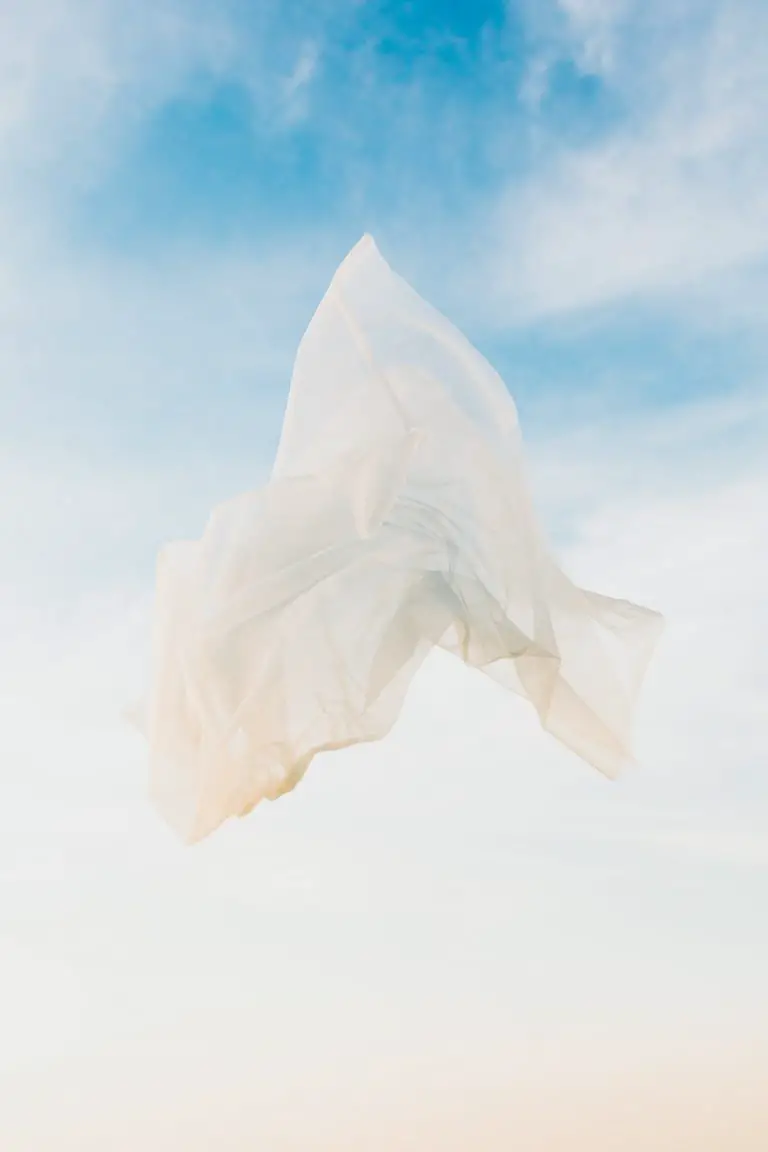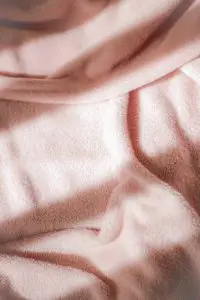When it comes to styling, Organza and chiffon are two leading choices in the fashion industry. These two materials are even more famous for bridal apparel. However, most people cannot tell the distinction between these two materials. For example, if you’ve gone shopping for a wedding gown, you might not be able to distinguish between Organza and chiffon. This Organza vs chiffon comparison will explain the differences between both materials. We’ll also touch on their basic properties and what you can use them for. On that note, let’s begin.
Organza vs Chiffon – What is Organza?
Organza is a popular material used in bridal apparel. It is transparent and very lightweight. Organza usually comes from silk, polyester, or nylon material. Although it is very smooth and shiny, it also has a stiff drape. This stiffness comes from the weaving method. At first, silk was the only material used in weaving Organza. However, when manufacturers created synthetic materials like nylon and polyester, they dived into using this material as well.
Organza originates from Turkestan, East Asia. This town was famous for its top-quality silk markets. The name organza originated from ‘Organzine,’ which means any fabric created using a spinning twisting method. Organza is available in varying colors and is popular for evening dresses and wedding gowns. Most designers use it because it adds volume to a dress. Therefore, it appears as lining under lightweight clothes that require more support and body without extra weight.
Because of its lack of elasticity, organza wrinkles easily, and you can iron it. However, washing in a washing machine might be a bad option because of its delicate nature. Handwashing and air-drying Organza helps to keep it in shape. However, Organza gets damaged quite easily, so there’s a need to be careful during maintenance and when washing it. Additionally, it’s essential to have the proper cutting and sewing paraphernalia when working with Organza.
Organza vs Chiffon – What is Chiffon Fabric?
Chiffon is a versatile term to refer to various fabrics sharing the same quality. The chiffon fabric is sheer, making it quite transparent and lightweight. Additionally, it is made using a simple weaving technique. Originally, Chiffon came from silk, and it was in high demand amongst the upper-class ladies in the United States. Because of the silk base material used in its creation, the middle class could not afford the chiffon fabric. The word ‘chiffon’ quickly became synonymous with any sheer fabric woven in a unique style.
Chiffon originated from France, but its production soon became worldwide with the arrival of the Industrial Age. Although silk chiffon was in vast production in Europe and United States, the producers began to grow interested in replacing silk as the only weaving fabric for chiffon. As a result, manufacturers created the first non-silk chiffon in 1938, and the producers used nylon. At the time, people viewed nylon as a miracle fabric that was quickly replacing other types of materials. However, people soon noticed a problem using nylon to create chiffon and soon reverted to silk as the only base material for chiffon.
However, polyester was developed in 1958 and soon became the standard material for creating chiffon. Polyester effectively mirrored silk in many ways, but it couldn’t offer the silkiness or softness synonymous with silk. To date, most chiffon comes from polyester. Several manufacturers also try to use rayon in the creation of chiffon. In some cases, cotton is popular in creating chiffon, but it isn’t as suitable as polyester and rayon. Although some manufacturers still use silk as the base material of chiffon, it is viewed as a luxury fabric today and is only available inexpensive materials.
Organza vs Chiffon – Prominent Differences
There are many similarities between Organza and chiffon. Most of the available formal and wedding dress fabric is influenced by the similarities between these two fabrics. Therefore, it could be difficult choosing between Organza and chiffon. However, in this section of the Organza vs chiffon comparison, we’ll be exploring the main differences between the two fabrics.
Fiber Content
One of the main differences in this Organza vs chiffon comparison is the fiber content. Natural fibers like silk and cotton are standard in creating chiffon. Silk chiffon is known for its softness, smoothness, and drape feature. However, some base materials used in creating Organza are polyester, nylon, and silk. Nylon isn’t typical in chiffon creation because of its stiffness and other notable differences. However, silk organza is also known for its flat weave and fineness.
Weaving Finish
Another notable difference is the weaving finish of both fabrics. Manufacturers of chiffon use a weaving technique that creates a lightweight, simple, and plain weave textile that offers a subtle sheen. In addition, the chiffon weaving technique adds little wrinkles to the material to add a slight roughness to the material. The same’s not the case with organza weaving finish; it utilizes a consistent manufacturing process once manufacturers generate the textile yarn. As a result, the weaving finish of Organza is consistent whether the material is synthetic or Organza.
Appearance and Texture
It can be challenging to tell the distinctions in this Organza vs chiffon comparison when it comes to appearance. Both materials are translucent and quite delicate to the touch. That’s why they’re a top choice for bridal gowns. However, while chiffon flows more freely and gives the dress a feminine flair, Organza is quite stiff. This material doesn’t flow well, so it is a common material for structured dresses that aren’t supposed to flow. Such structured dresses showcase the wearer’s body and beautiful features.
Although chiffon can be pretty soft, it is also known for its roughness and standard thickness. On the other hand, Organza offers different thickness variations depending on the fabric used in its weaving. A thick organza fabric can be sheer and quite flowy. On the other hand, thick Organza is usually as stiff as a burlap. Another notable difference in the Organza vs chiffon comparison is that while chiffon offers a certain sheen level, Organza is more matte.
Functionality
You also need to consider the differences in the two fabric’s functionality. Both are pretty similar in many ways. They wear well and do not wrinkle as quickly as other materials. Chiffon is exceptionally breathable and is an excellent choice for outdoor weddings, summer brides, and summer evenings. On the other hand, Organza is popularly used as a feminine top layer as it helps to give structure to a bodice or a softer fabric. It overs dual function by adding to the appearance while still offering functionality. However, chiffon provides more in terms of appearance than functionality. When attending formal functions, you can easily choose between both materials to stand out.
Maintenance
You might be wondering which of the two materials is easy to clean. Chiffon fabric is easier to wash than organza materials. Due to its high delicateness, Organza cannot be machine-washed. Instead, you can only hand wash and dry-clean this material. However, when dealing with silk chiffon, it is vital to only dry-clean them. We also recommend using mild soap and cold water when maintaining chiffon products. Therefore, many would agree that maintaining chiffon is far easier than Organza.
Organza vs Chiffon – What are Chiffon Properties?
Chiffon is a lightweight fabric that features a plain weave and a slight sheen. It comes with tiny wrinkles that tend to make the fabric look scratchy. These small wrinkles are created through crepe yarns twisted in opposite directions. Below are the chiffon properties you should note in the Organza vs chiffon comparison.
- Chiffon is floaty, transparent, and a shimmering fabric that closely resembles tissue paper.
- When held under a magnifying lens, chiffon looks like a mesh or thin net.
- The yarns weaved in different directions create little puckers in chiffon.
- Chiffon also has a subtle elastic texture because of the directional weaving. However, silk chiffon offers more stretch than polyester chiffon.
- The strand twisting and tight weave make the chiffon fabric look robust.
- Chiffon offers a level of sheen to the wearer.
- There are different varieties of cotton-like polyester, cotton, and silk.
Organza vs Chiffon – What are Organza Properties?
Organza is lightweight and also features a plain weave. It is heavily woven with a low density, making it light and translucent. Its transparency and breathability are why it is ideal for bulkier clothes. You can also utilize this fabric for home textiles. Although it started with silk, you can now create this textile using different materials like nylon and polyester. Because of its delicateness, it is best dry-cleaned by a professional. Below, you’ll find some of the remarkable properties of Organza you should take note of.
- It is translucent and thin
- Organza’s quality usually increases with the hole count per inch
- It is woven with tightly-twisted strands to provide transparency
- It reflects rays quite easily and is a unique light catcher
- Most designers use it for creating structured dresses because of its rigid drape and wiry texture
- It is pretty breathable because of the featured perforations
- Because of its thinness, it wrinkles and tears easily
What is Chiffon Used for?
Chiffon is popular for evening wear, high-fashion dresses, and bridal gowns. You can utilize it to add depth and volume to a cloth. In addition, you can add a chiffon scarf to add elegance to your look. Chiffon is popular in making summer dresses because of its airiness and lightweight. It is also common in the production of ornamental upholstery and transparent curtain. Its transparency allows light to pass through the fabric easily. Chiffon is also a common choice in the production of dupattas and sarees, which are traditional Indian clothes. It is also popular in other color-wrapped gowns because of its ability to dye well and drape elegantly.
What is Organza Used for?
Organza is a top option for formal dresses. However, you can also find it in home décor and costume designs. When using satin for a dress, layering Organza over them gives it depth and sheen. It is also a common choice for bridesmaids and wedding dresses because its stiff shape and drape draw attention to the wearer’s soft, full shape. This fabric also comes in handy in producing sheer curtains and many seating accessories. Sometimes, Organza comes in handy for creating drawstring purses that hold jewelry. It is also a favorite for theatrical costumes because of its ability to capture light.
A Great Online Class: Color Theory for Textile Projects by Domestika
If you are interested in learning more about how you can create a successful name for your business, we recommend taking a look at the online class “Color Theory for Textile Projects”.
The course is currently under promotion, but you can use the discount code: T_BROWNLEES-PROMO to get an additional 10% discount on your purchase.
This online class offered by Domestika, at a very inexpensive price covers all you need to know to develop your textile project by leveraging color theory to create the perfect color palette. If you apply to the course through the link below you’ll be supporting 440 Industries, and we thank you for it!
Organza vs Chiffon – Final Verdict
When choosing a fabric for your formal dress or wedding apparel, choosing any of these materials is always a good choice. Both materials are soft and quite transparent. However, this Organza vs chiffon comparison clarifies the differences between both materials to help you choose. Your choice depends on your desired appearance and needs.







